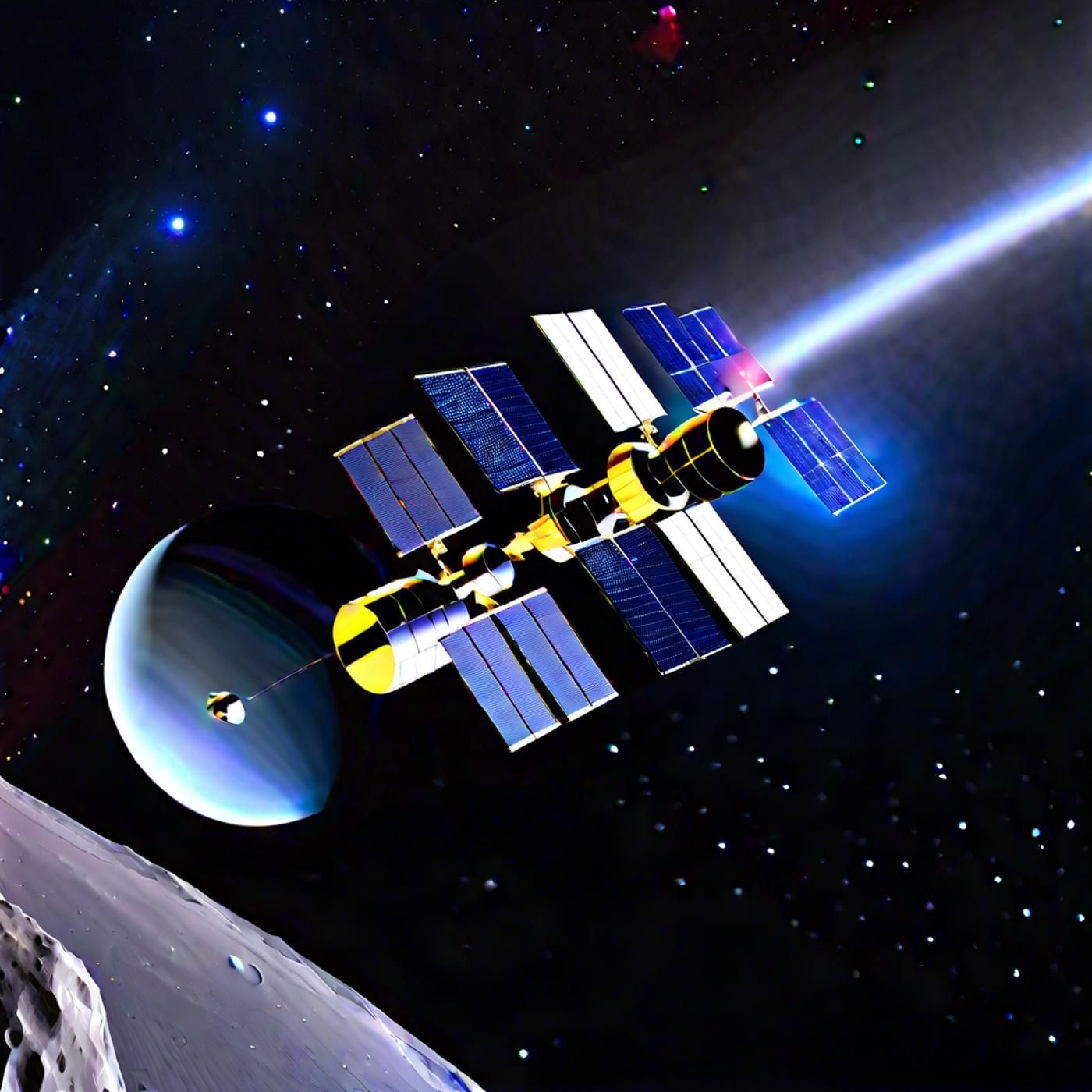S03E71: Primordial Black Hole Puzzle & Virgin Galactic's New Era

Embark on a celestial journey with today's episode of Astronomy Daily - The Podcast, where your host, Anna, brings you the latest cosmic updates. We'll start with recent research revealing a surprising shortage of primordial black holes, challenging...
Embark on a celestial journey with today's episode of Astronomy Daily - The Podcast, where your host, Anna, brings you the latest cosmic updates. We'll start with recent research revealing a surprising shortage of primordial black holes, challenging our understanding of dark matter and the universe's structure. Next, we'll explore a breakthrough in autonomous multi-robot planetary exploration, enhancing the efficiency of missions to Mars and beyond. We'll then cover Virgin Galactic's final commercial space flight before a significant fleet upgrade, aiming to boost space tourism profitability. Additionally, we'll delve into new findings on turbulence dynamics in the thermosphere, offering insights that could improve space weather forecasting. Discover the intriguing phenomenon of a puffed-up exoplanet, Pheonix, which defies expectations by retaining its atmosphere despite intense stellar conditions. Lastly, we'll discuss the groundbreaking creation of the largest 3D map of the universe, providing new perspectives on cosmic expansion and dark energy. Stay with us for an exciting journey through the cosmos.
For an astronomical experience, visit our website at astronomydaily.io for the latest news, sign up for our free newsletter, and check out exclusive sponsor deals.
Connect with us on YouTube, TikTok, X and our new Facebook page via @AstroDailyPod for engaging discussions with fellow space aficionados. This is Anna, reminding you to keep your gaze fixed on the heavens. Until our next stellar episode, let the cosmos ignite your curiosity and wonder. Clear skies and cosmic discoveries to all!
Support:
The podcast is better with your support:
https://www.bitesz.com/show/astronomy-daily-the-podcast/support/
www.bitesz.com
Sponsors:
www.bitesz.com/nordpass
https://www.bitesz.com/show/astronomy-daily-the-podcast/sponsors/
Welcome to Astronomy Daily, the podcast where we dive into the latest developments
Anna: Welcome to Astronomy Daily, the podcast where we dive into the latest developments in the world of Astronomy and space science. I'm your host, Anna. In today's episode, we'll cover intriguing topics such as a surprising shortage of primordial black holes, autonomous multi robot planetary exploration, Virgin Galactic's latest space flight, new turbulence dynamics findings, a puffed up exoplanet, and a groundbreaking map of the universe. Let's get started. the Astronomy Daily Podcast.
Recent research using quantum field theory reveals potential flaws in existing black hole models
Recent research using quantum field theory has unveiled potential flaws in existing models that predict a significant number of primordial black holes in the early universe. This revelation could have profound implications for our understanding of dark matter and the structural composition of the universe. Scientists from the University of Tokyo, specifically those affiliated with the Research center for the early universe Resciu, and the Kavli Institute for the Physics and Mathematics of the universe, Kavli Ipmuwpi, have found that small scale fluctuations in the early universe might not result in the large scale fluctuations we observe today. This insight suggests that the formation of miniature black holes during the universe's infancy might be far less common than previously assumed. Using quantum field theory, a well established framework in the study of particle physics, the researchers have proposed a new model for primordial black hole PBH formation that better aligns with current observational data. According to their study, early small scale fluctuations could have amplified larger waves in the cosmic microwave background cmb, but not necessarily create a high number of pbhs. This correction to previous models highlights the possibility that the universe contains fewer pbhs, which are thought to be strong candidates for dark matter than was once theorized. The implications of this research are significant. If fewer pbhs exist, it challenges current theories that link these black holes with dark matter. It also prompts a re evaluation of the conditions and processes during the universe's formative moments. As ongoing observations from gravitational wave observatories like Ligo, Virgo, and Kagra continue, we can expect further refinement and validation of these findings, potentially reshaping our understanding of the cosmos.
University of Glasgow researchers develop new methodology for multi robot autonomy on Mars
Exploring other planets has long presented a challenge to scientists, especially when it comes to ensuring that robotic systems can autonomously operate without issues. Researchers at the University of Glasgow, um, have now made a significant breakthrough in this area, developing a new methodology that allows teams of multiple rovers to explore planets like Mars more efficiently and autonomously. This innovative method integrates data from various sources, such as imaging maps and sensor information, to generate highly detailed maps and plan optimal routes for each rover. By leveraging this wealth of data, the rovers can navigate complex terrain safely and effectively, significantly enhancing the scientific capabilities of planetary missions. One of the key benefits of this approach is its ability to tackle the long standing problems of coordinating multiple robots in extraterrestrial environments. Each rover in the team is equipped to operate independently, which not only minimizes the communication latency issues that arise from Earth to Mars operations, but also allows for the simultaneous exploration of larger areas. This coordinated effort boosts the efficiency of scientific missions, potentially revolutionizing our approach to autonomous space exploration. By enabling multi robot autonomy, researchers aim to expand the scope of planetary exploration, paving the way for more ambitious missions that could yield unprecedented discoveries about our neighboring planets.
Virgin Galactic completes final commercial space flight before embarking on fleet upgrades
Virgin Galactic has recently completed its final commercial space flight before embarking on a two year pause to upgrade its fleet. The Galactic Zero seven mission was a milestone event, featuring a team that included two pilots and two passengers who had the unique opportunity to experience a few minutes of weightlessness during this brief period. They also managed to take in the breathtaking view of the Earth's curvature from the edge of space. This mission represents the last voyage for Virgin Galactic's current space plane. VSS unity over the next two years, the company plans to replace VSS unity with two next generation delta class space planes. These new spacecraft are designed to carry six passengers as opposed to the current four, and they aim to significantly increase the frequency of flights. It's a pivotal time for Virgin Galactic as they attempt to turn a profit in the burgeoning space tourism market. Despite its high profile achievements, the company has been struggling financially, recently, losing more than $100 million in each of the past two quarters. The upgrades mark a strategic effort to boost revenue, increase passenger capacity, and improve operational efficiency with enhanced fleet capabilities. Virgin galactic projects they will be able to conduct up to 125 flights per year, with ticket prices starting at $600,000 per seat. As they enter this critical phase, all eyes will be on whether these improvements help virgin galactic finally break even and establish a sustainable business model in the competitive field of space tourism.
A Neptune sized exoplanet named Pheonix has retained its atmosphere
A fascinating recent study published in Geophysical Research Letters has brought to light that turbulence in the thermosphere mirrors the same physical laws governing wind in the lower atmosphere. This revelation offers groundbreaking insights into the dynamics of our upper atmosphere and holds potential for improving both earth and space weather forecasting. The research team, led by Professor Hui Shin Liu of Kyushu University, applied meteorological techniques traditionally used for lower atmospheric studies to the realm of space physics. They found that the energy flows and dissipation patterns in the thermosphere exhibit striking similarities to those in the troposphere. Despite the drastically different atmospheric compositions and dynamics in these regions. This discovery means that the processes driving turbulence in these two vastly different layers of our atmosphere can now be better understood and predicted. Such knowledge is critical not only for advancing our understanding of atmospheric science, but also for ensuring the functionality and safety of satellite based technologies that our modern world relies on. Astronomers have made a fascinating discovery in the realm of exoplanets. A Neptune sized exoplanet named Pheonix has retained its atmosphere by an unusual process known as puffing up. This rare phenomenon among hot Neptunes allows Pheonix to maintain its gaseous envelope despite its close proximity to its host star. Typically, one would expect such planets to lose their atmospheres due to the intense heat and radiation from their stars, but Pheonix seems to defy this expectation. Phoenix, identified through a combination of data from NASA's transiting exoplanet survey satellite TESS and radial velocity measurements from the Keck Observatory, is unique. It is about 0.55 times the size of Jupiter but only 0.06 times as massive, making it incredibly low in density. This discovery suggests that Pheonix is the puffiest puff planet found to date. Its star is a red giant, and phionics orbits it six times closer than Mercury is to our sun. What makes this discovery particularly intriguing is its implications for our understanding of planetary evolution and atmospheric retention. The findings challenge current models that predict atmospheric loss for similar exoplanets in such hostile environments. This unique case of pheonix could provide new insights into how planetary atmospheres can survive intense stellar conditions. Furthermore, this discovery might have broader implications for predicting the future evolution of Earth's atmosphere. As our sun ages and transforms into a red giant, Earth's atmosphere might also undergo unexpected changes, potentially expanding rather than being stripped away. The continuous study of unique exoplanets like Phoenix not only broadens our understanding of the mechanics of atmospheric retention, but also offers valuable clues on the future dynamics of planetary systems, including our own. The DSE collaboration has taken a monumental leap in our understanding of the universe by creating the largest 3d map of cosmic history ever constructed. This unprecedented effort has allowed researchers to gather invaluable insights into the nature of cosmic expansion and the elusive phenomenon of dark energy. By meticulously tracing the universe's evolution from its nascent stages to the current epoch, DSE scientists have unveiled intriguing hints that dark energy might be evolving over time. This groundbreaking work challenges the conventional models of the cosmos, offering new perspectives on the forces that drive the accelerating expansion of the universe. Dark energy, which counterintuitively causes the universe to expand faster over time has been a cornerstone of modern cosmology's enigmatic puzzles. The DeSE findings suggest that our understanding of this mysterious force could be incomplete, potentially requiring revisions to existing theories. Operating from the Kitt Peak National Observatory in Arizona, the DeCI instrument gathers light from the most distant reaches of the cosmos. This light serves as a time machine of sorts, enabling scientists to observe the universe as it was billions of years ago and trace its transformation to present day. The level of detail and precision offered by DC's data is unmatched, allowing researchers to measure the expansion history of the universe with extraordinary accuracy. One particularly compelling aspect of the DSE findings is the confirmation of subtle deviations from the standard lambda CDM model, which is the prevailing cosmological model. These deviations potentially hint at an evolving dark energy scenario, where the properties of dark energy might change over cosmic time. Such insights are crucial, as they could reshape our understanding of, uh, fundamental physics and the ultimate fate of the universe. This revolution in cosmic mapping not only enhances our grasp of the universe's past, but also equips us with tools to predict its future. The continuing work of the DESE collaboration promises to further illuminate the nature of cosmic acceleration and deepen our comprehension of the intricate tapestry of the universe. Thank you for joining us on this episode of Astronomy Daily. We hope you enjoyed our discussions on the latest astronomical discoveries. Don't forget to visit our website at astronomyDaily IO for more news, back episodes, and links to our social media and sponsors. Follow us on YouTube, X, TikTok and our new Facebook page at astrodailypod. I'm Anna, and we'll catch you next time.
New to Astronomy Daily - The Podcast?
Here are some great episodes to start with.



















